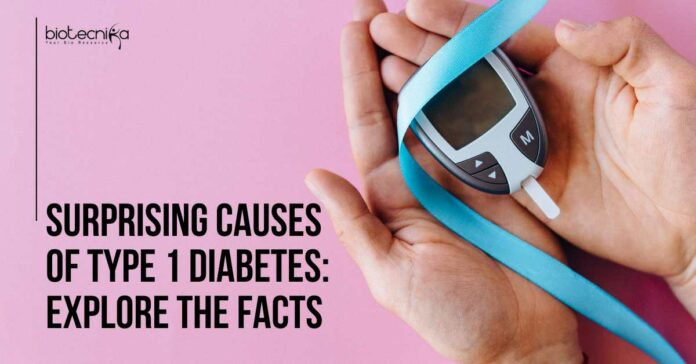Causes of Type 1 Diabetes: Explore the Facts
Nick Jonas (an American pop singer) once said, “I think back to 13-year-old, newly-diagnosed me, sitting in the hospital room, kind of wondering what my new reality was going to be. I didn’t have anyone at the time, or a person living with type1 diabetes in the public eye, that that I could look up.” This is horrifying, right?
For ages, handling sugar levels has been a challenge that many people are facing worldwide. A disease that is messing up with people’s bodies is an autoimmune disease called Type 1 Diabetes (T1D). This disease confuses, surprises, and inspires scientists for new research.
Usually this disease is seen in childhood or early adulthood, but it can develop at any age. It makes the person insulin-dependent for the rest of his/her life. However, we have to thank modern technology, which helps patients deal with T1D smoothly, from regular glucose monitoring to artificial pancreatic systems.
Glucose can move from the bloodstream to the patient’s cells with the help of insulin. Insulin is an important hormone that is produced by the beta cells of the pancreas, and this will help to maintain the body’s blood sugar levels.
According to the recent research published by the Division of Infection and Immunity, Cardiff University School of Medicine, Cardiff, Wales, United Kingdom, bacterial infections can act as a trigger for this immune response.T1D is not caused by factors such as lifestyle, whereas it is caused by the immune system attacking the insulin-producing cells of its own body.
The lead author, Andrew Sewell, says- in their previous research, they associated the loss of insulin-producing tissues with a group of white blood cells i.e, the killer T-cells, cells infected by a pathogen or cancer cells. By killing the beta cells, killer T cells play an important part in causing type 1 diabetes.
The author- presenting the new research says that killer T cells start this when activated by bacterial proteins, mainly the proteins from Klebsiella oxytoca, a bacteria that is known to infect humans.
Andrew Sewell’s team conducted experiments in the lab to affect such infections by giving bacterial proteins to cell lines belonging to non-diabetic human donors and noticing how the donor’s killer T cells reacted.
The team found-
- The proteins from some infectious bacteria, such as killer T cells, can kill cells that produce insulin protein mistakenly.
- Activated T cells that had the same ‘cross-reactivity’ in the patient’s blood who had T1D, which leads to the belief that what they observed in the lab experiments might have triggered the disease.
- The change in killer T cells’ behavior might be due to the powerful interaction with bacterial proteins.
- The team saw this in association with genes for a protein in cells known as “human leukocyte antigen”(HLA), which permits the immune system to keep the tissues apart from invaders.
- In the UK, approximately 3% of people have the specific HLA linked to the bacterial infection that causes diabetes.
- The bacterial pathogens that are able to produce anti-insulin T cells are caused by a rare infection in a small minority of people.
- By explaining the origins of T1D, new ways can be found to prevent or treat this disease.
- The understanding of how T cells trigger diseases like T1D will help to treat and diagnose the disease before the symptoms start.
- Additionally, early treatment gives a better prognosis; the healthy pancreatic beta cells are under attack before they are killed, which is known to lead to a better prognosis.
- Patients have to take life-long treatment as there is no cure for T1D .
Patients with T1D are prone to develop medical complications in the future; therefore, there is an immediate need to know about the fundamental causes of the illness in order to come up with more effective treatment.
This news sounds like a twist from a sci-fi movie, scientists finding that bacteria infections might be the criminals behind Type 1 diabetes. This research opens up to a wide range of possibilities for treating and preventing T1D. This news is like a reminder to all of us about our body’s complex ecosystem, and there are always new possibilities that might happen anytime, anywhere, and any day. Be ready to read, hear, and learn more about this tricky disease(Type 1 diabetes).



























